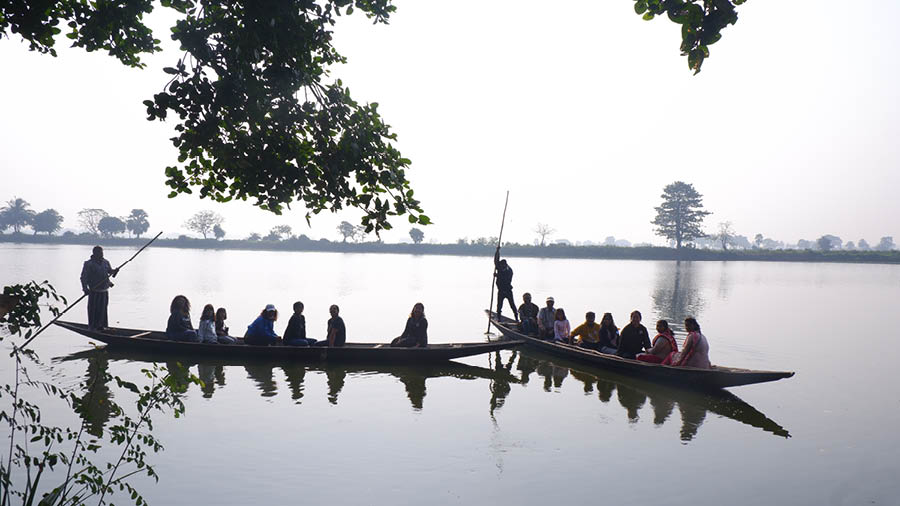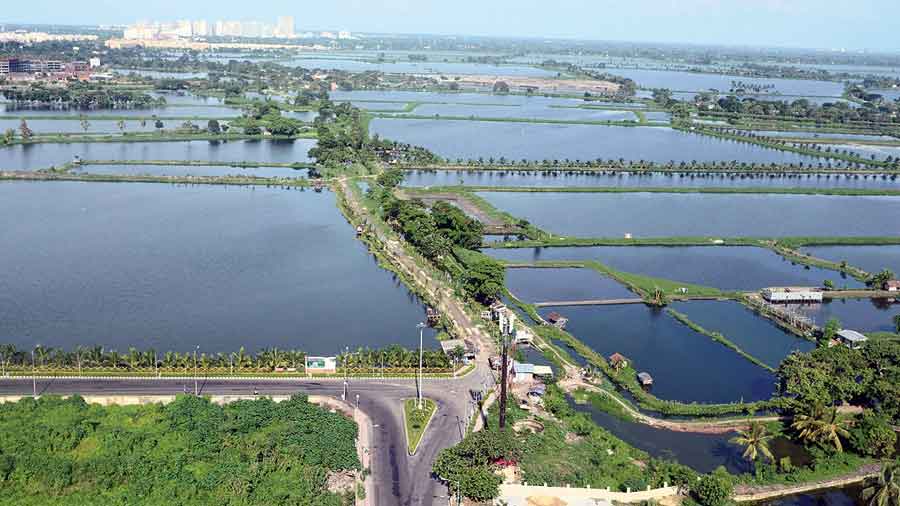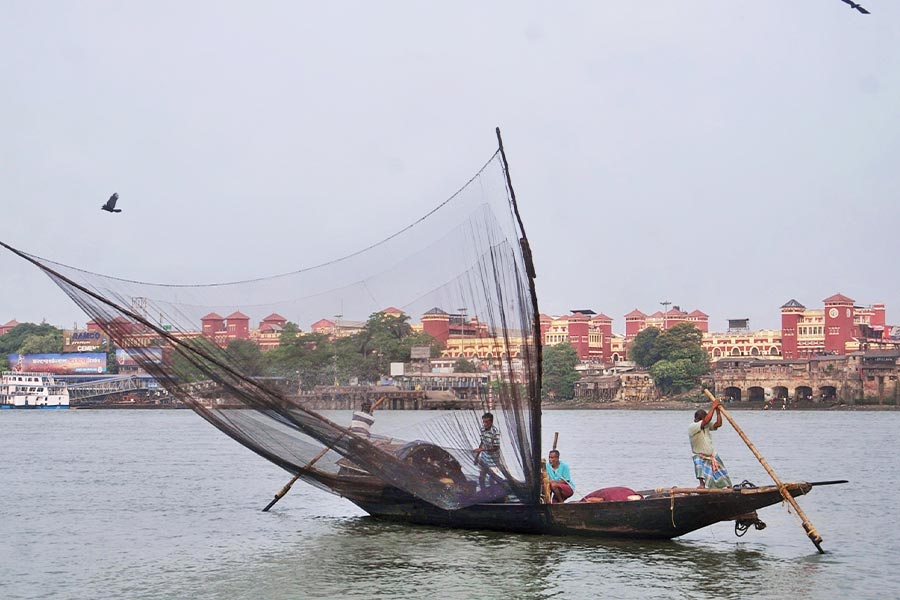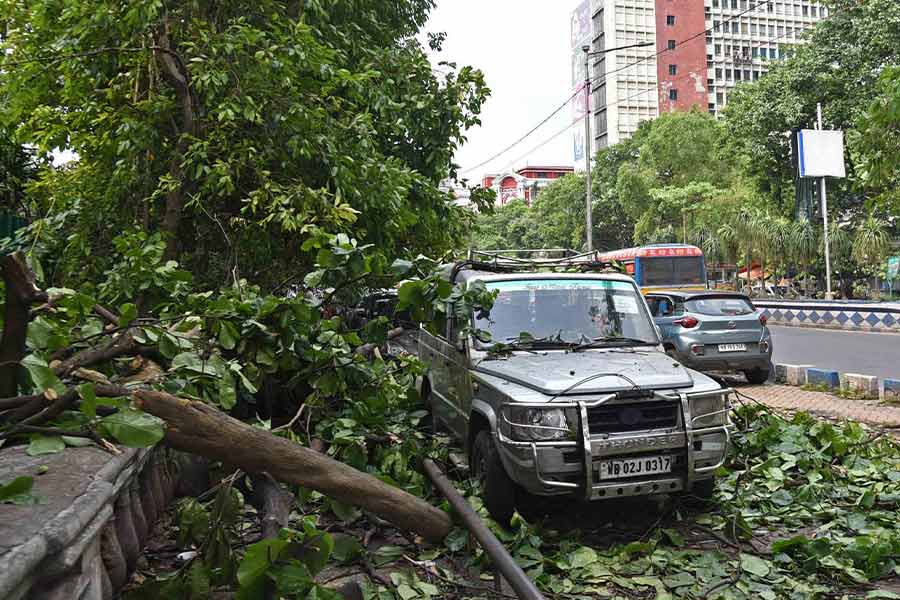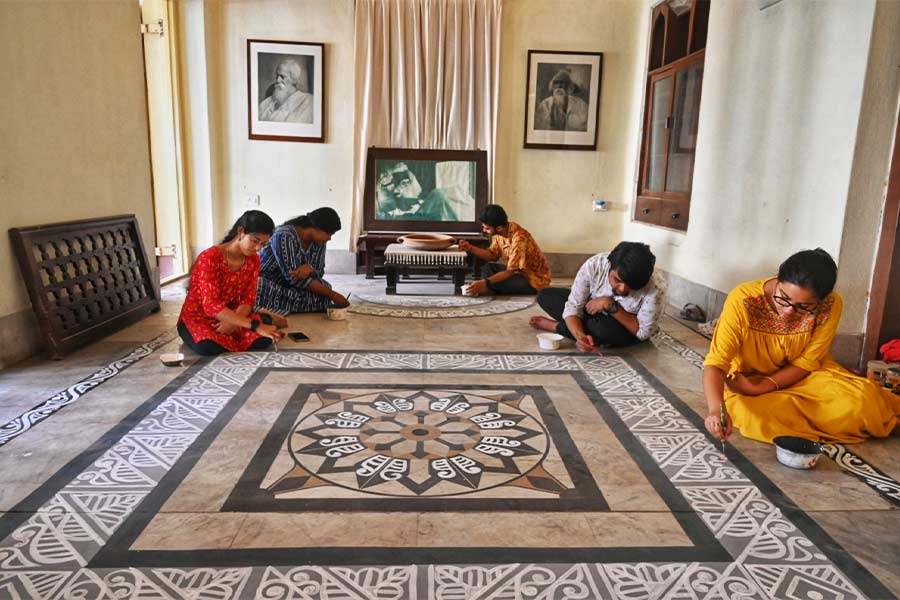The drastic transformation of the East Kolkata Wetlands in the past few years has prompted an artist to use her interdisciplinary art practice to spread awareness about its importance and bring city dwellers closer to the green space.
Why East Kolkata Wetlands
Nobina Gupta broke down the significance of the East Kolkata Wetlands into three main pointers. “The first is waste management as it handles a bulk of the city’s waste. The second is food production. Kolkata wouldn't survive without the fresh fishes and vegetables we get here. Moreover, while there is no control over the fertilisers in the food we import from other places, wetlands are an organic treatment plant existing just beside us. They even treat the waste water organically, which goes into the Kulti river and becomes the basis for cultivating a variety of fishes. It is not just a waste management system, but a circular economy. Thirdly, this region is crucial for climate mitigation. The East Kolkata Wetlands are the second buffer zone to Kolkata after the Sunderbans and are the reason why we have remained stable in response to so many cyclones. If we don’t take care of this region, the air we breathe will drastically degrade,” she explained.
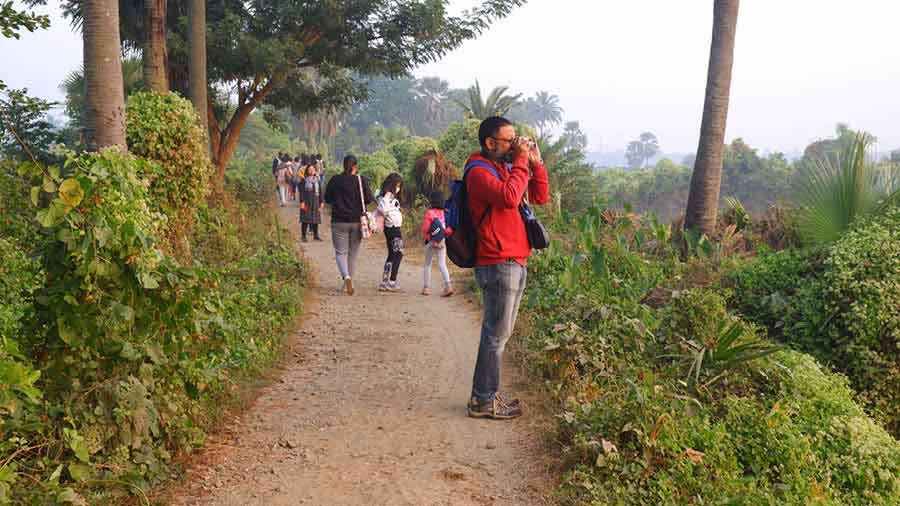
The Wake up to the Wetlands trail takes people through the beauty and significance of the wetlands and is led by community eco guides
But the wetlands have their own problems. The area doesn’t fall under the Kolkata Municipal Corporation and this makes waste management a major issue. Despite the wetlands and community managining the waste of the entire city, they have no support for their local waste management.
Earlier projects
Gupta’s diverse work includes a project at the Chhatrapati Shivaji Terminus, the busy railway junction in Mumbai. “I laid long canvases on the ground and people walked over it, leaving their footprints. We recorded interviews of people, centred around the years they had travelled through the station, their thoughts about the city, and the impact their lives were leaving behind. The idea was to engage with them and see how people reflected upon what they were going to leave for the next generation.”
But Gupta constantly found herself plagued by a desire to dig deeper and reach more people. “I was not feeling complete because my work was not doing what I wanted it to do. I wanted my art to mean something more to people, where it was appreciated from a grounded perspective rather than just with wine and cheese.”
This took Gupta to Ladakh where she recorded and researched on the biodiversity of medicinal plants. “I always thought Ladakh was nothing more than just a cold desert, but I couldn’t have been more wrong.” She worked with nomads and schoolchildren to find out important aspects of their everyday life, including how they built their houses.
“We travelled to small villages and stayed there for two months with schoolchildren, creating art with the community in the form of a pop-up museum.”
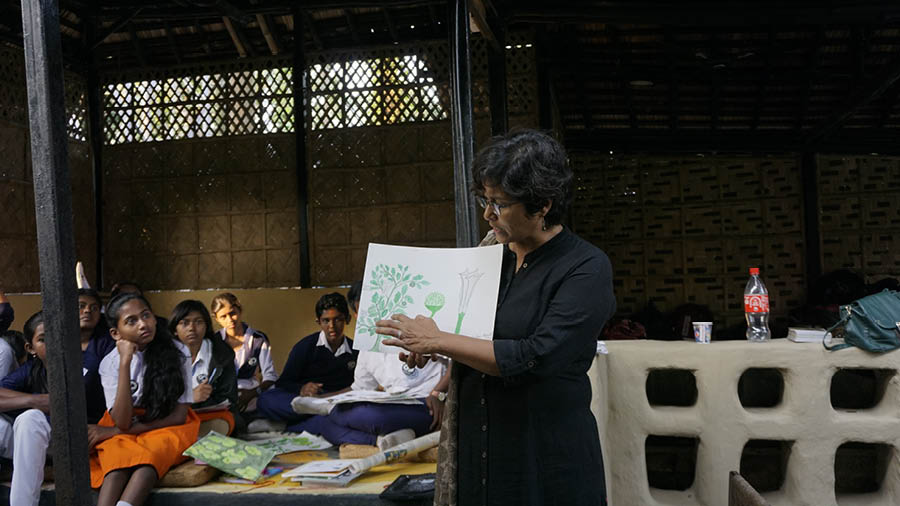
Gupta at her nature explorer lab with schoolchildren
Gupta was moved by the relationship between the children and the environment. While noticing them run up hills and effortlessly identify integral details about the plants around them, she stumbled upon the most powerful way of expressing herself. “I felt that this could be a way to address crucial issues and empower the people holding this knowledge, who are custodians of sustainable life. We city dwellers are not aware of these treasure troves which lie unnoticed around the country and are disappearing. I realised that the youth needed to connect with traditional practices and build a future from it.”
Gupta noticed the same trend while working with tribals in the Bundelkhand and Baghelkhand regions of Madhya Pradesh. “A lot of the youth took up work as labourers around the country because of lack of opportunities within their community. My project explored the crucial connection between their traditional practices and farming, which is unknown to people outside.”
Home ground
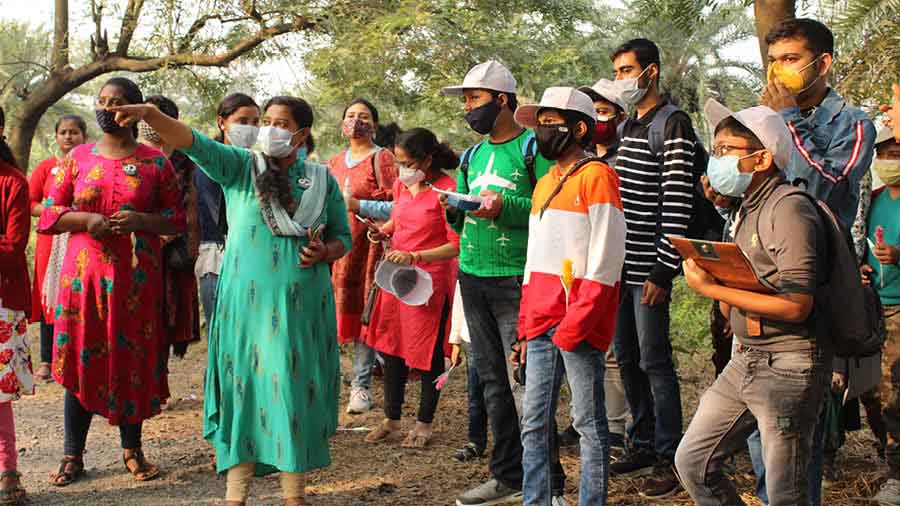
Gupta at the Wake up to the Wetlands Trail
Gupta took her learnings from these projects and applied them closer home. “The East Kolkata Wetlands is not far from my home and I would often go towards Bantala just to get a little fresh air and move away from the hustle bustle. However, the transformation of the area over the last six years has been shocking. Every month we would go and see that water bodies had disappeared, buildings were coming up and waste was being dumped. It was a drastic change from the narrow roads that didn’t even accommodate cars.”
Seeing the vulnerability and importance of the region, Gupta decided to get involved with Kheadaha High School and Bamanghata High School six years ago. “We started researching on the way school students saw themselves and it was surprising how they had no clue about their surrounding environment. They felt that they were part of Kolkata, with the highrise buildings of Rajarhat on the other side. It was appalling how the East Kolkata Wetlands were beside the city and people had no clue about it.”
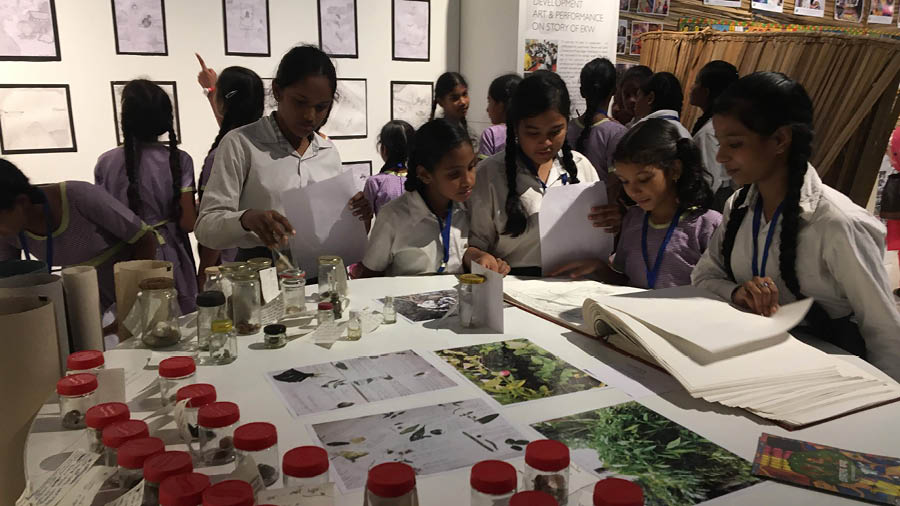
Children working on creating a nature journal to promote dialogues about biodiversity, ecology and conservation
Lessons for children
The children were taught to make paper with banana leaves and are now learning how to weave.
Gupta, along with her team at Disappearing Dialogues, created a song with music therapist Rajat Mallick to create awareness about the community. Her primary focus remained the intersection of art with the children. “We developed a small art and dance performance with the children, and showcased their work at Kolkata Centre for Creativity with the support of the German Consulate. The children spoke about their practices in an interactive capacity, and people were shocked at the expanse of the East Kolkata Wetlands.
A step further
But for Gupta the depth of learning is of importance. “We always ask students at our workshops if they truly understand sustainability, beyond the terminology.”
So taking her effort further, she became part of a collaborative project with the Indian Foundation of Arts and PARI in 2021. “We kept asking why museums had to be static, and started working to transform archives into living museums. Our goal was to empower children to find their stories and talk about them through art, poetry or writing. PARI’s online education platform has already published two photo stories taken by the children. While their mobile cameras are basic, their photography is amazing.”
Finding and bringing out these stories, Gupta hopes, will help other children of fishermen or ragpickers relate because the lack of dialogue surrounding these professions often leads children to shy away from them. “The narrative has been about parents working in offices in big cities, but we want the kids to see value in practices that don’t conform to them. Every child in the Wetlands should feel, ‘My father and mother do something very unique and their work is important.”
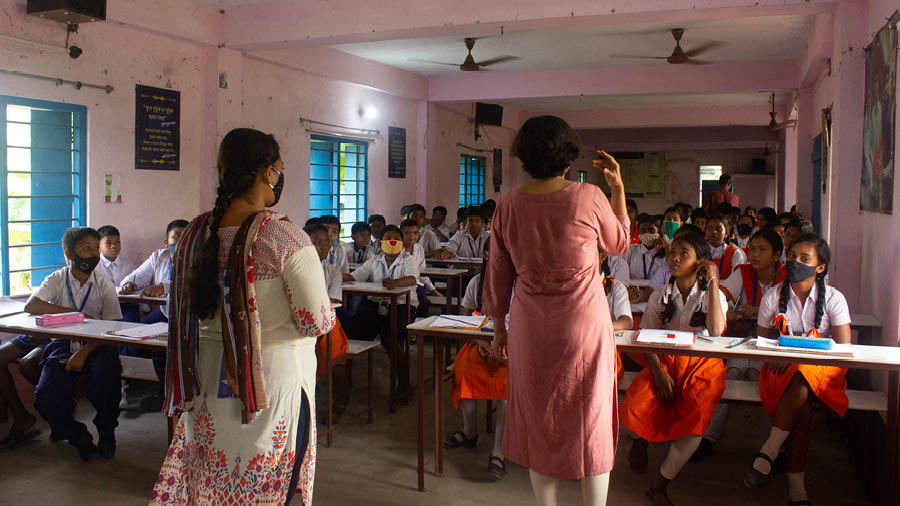
Biodiversity session at Kheadaha High School
Focus on community
Gupta’s work in the East Kolkata Wetlands centres around its community. Terming it as a perpetual ‘work in progress’, Gupta shared that her vision is for the community to feel valued for their services and the work that they do and for society to recognise the lives they lead.
“All over the world, there are many practices which are as recent as our grandparent’s generation, but have been lost. Luckily, many such practices still exist in India, and my work in the Wetlands made me realise that every corner and village has something valuable.”
The stark contrast between our lives and theirs is powerful enough to highlight the problem. “Fishermen sometimes have to go to ponds at 3am, be it summer or winter. We have these fancy platters in city restaurants without realising how the fish arrived on the plate. If we don’t value their profession, a fisherman loses his practice and becomes a labourer or guard in the city. We as citizens need to create value for them and give alternatives for their children which are not created from outside, but from their own dreams and aspirations.”

Art and ecology sessions at Bamanghata High School
Need for research
Noting the scattered nature of research work in the East Kolkata Wetlands, Gupta is also driven to organise this setup. “We are trying to create a collective that brings together researchers from different fields who can work in a simple form and their findings can easily be understood by common people. Although we have segregated ourselves according to specialisations, working together is the ideal way to make progress,” she said.
Lack of awareness remains a recurring theme in her research and, for this purpose, Disappearing Dialogues has introduced eco trails every month. Titled ‘Wake up with the Wetlands’, people from the city are given a guided tour of the area and allowed to witness the beauty in person. “We give the youth from the community fellowships and train them as eco guides. They take people from the city to see the practices and the environment early in the morning, as nothing can substitute being there physically.”
Small steps
Some steps have been taken to prevent encroachment, but the effort is far from enough. Gupta urged people to amplify the movement, for a stronger penalty on encroachment and more funds for rejuvenation.
“The waste water we used to generate was more organic, but we use more synthetic products now. This will come back to us with how it is affecting fish production and livelihoods in the wetlands,” she said.
The need of the hour, Gupta said, is to perceive the wetlands as an asset rather than pondering over the damage that has been done. “Our motto is no longer to ‘Save the Wetlands’, but to keep it alive for our own good and sustainability. People won’t be bothered when you talk about the other house getting burned, but are affected when they realise that their house will burn with it. If we lose this place, we will have no way to get it back. You can't rebuild a forest. They are natural spaces and need to live with the community that knows it.”

Boichitro — understanding diversity through art, a session at Jolabhumi Utsav at Emami Art Gallery
The artist
Born in Jabalpur, Gupta clearly remembers being the first in her family to be attracted to art. “Both my parents were doctors, but I was always interested in art. After completing school, I did both my bachelors and masters at Kala Bhavana, Visva-Bharati, Santiniketan.”
For five years, Gupta worked as a faculty at Apeejay Institute of Design, New Delhi, before realising that she wanted something different.
“It dawned upon me that if I gave all my time to the institute from 9am to 5pm, I wouldn’t be able to do the things that I really want to focus on. So, I shifted from Delhi to Kolkata and started an art school because I wanted the younger generation to connect with their own experiences and their notions of the world through art.”

Gupta’s work at the Museum for Contemporary Culture
The shift also allowed Gupta to make time for her own artistic practice and focus on the environment. “As an individual staying in Santiniketan, who frequently trekked in the Himalayas, I always felt connected to nature. Every year when I went to the hills, the loss of nature brought about by development was alarming. My artistic lens began accommodating the microscopic details I observed and the larger connection they had to the world. This triggered me to begin Disappearing Dialogues (www.disappearingdialogues.org), and our motive became to showcase how city dwellers felt so distant that they couldn’t relate to what was happening around them and only focussed on their rat race.”
As Gupta transformed her ideas into art, she had her first first solo exhibition, Beneath the Surface, at Gallery Sanskriti in 2011. “It was about how unseen life exists under the surface, be it in the air, the environment or our bodies. The idea was to help people connect to their bodies and environments, through a catalytic movement.”
Gupta has since put together several exhibitions not just across India, but also in Switzerland. The expanding extent of her work also percolated into her medium.
“As a student I’ve mostly been attracted to temperas and traditional methods and would do large-scale drawings based on nature. Later, I started doing canvases. My installations have been on paper pulp and metal, steel and aluminium too. I have also worked on public art projects where the medium hasn’t been static, and we have manoeuvred light and sound. There have also been some projects with digital art, photography and archival prints. For me, the medium has always been secondary to the idea,” Gupta said.
Recognition
Gupta was awarded the Prakriti Research Fellowship in 2022 to support her work in biodiversity. Through this project, she has been recording the birds around water bodies in each region and their interrelation.
“When we identify a tree, we don’t just try to understand the kind of birds who come there, but also their characteristics, their migratory tendencies and more. They add to the rich biodiversity.”


